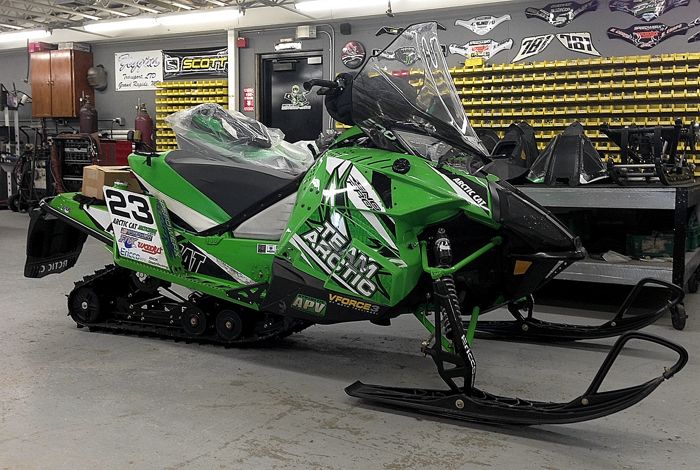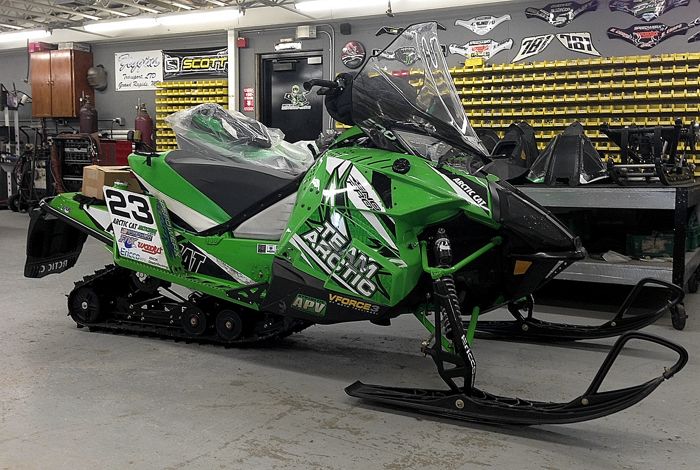
In the 2013 edition of the Alaska Iron Dog race, Team Arctic’s Brian Dick and Eric Quam paired as a potent team capable of winning the rugged event.
Running a pair of Arctic Cat Sno Pro 600 race sleds with a host of modifications, the duo were running in second place heading into the last few hundred miles of the event, with a shot at the win, when two component failures ended their bid.
What does it take to build a potential race-winning sled for Iron Dog?
“It was a joint effort to build the sleds,” says Brian. “The sleds were shipped stock, off the assembly line, to Eric in Alaska, where he and Brad Helwig essentially tore them down and reassembled according to plan.
“I built some of the custom components here, then Joe Lesmeister and I joined Eric and Brad for a week of additional work, about a month before the race. We also had a lot of help from Jack Klayum and my dad Paul.”
A significant change on the 2013 sled compared with the previous year was the addition of oil injection on the Sno Pro 600 engine, to save time at the checkpoints by eliminating the hassle of premixing fuel.
According to Brian, “This took a lot of extra work because the race engine isn’t designed with an oil pump. Being the wizard that he is, Eric machined some stuff on an oil pump to get the ratio that we wanted. We designed a reservoir (See the aluminum tank behind the muffler -Ed.) that fit around the recoil and worked well.”
To run on the 87-octane fuel provided by the race, the 600 race engine was de-tuned with lower compression heads and double-ring pistons.
Jetted for -40º F, Antifreeze coolant to -50º F.
Adequate storage is a key ingredient to a successful Iron Dog program. A modified seat cover incorporates a zippered rear storage pouch large enough to contain a tool kit, oil measuring cup and a few spare parts like brake & throttle levers.
The cockpit of each sled incorporates additional storage via Arctic Cat accessory bags. The end of the brake lever was chopped off to clear the stacked windshields. The stock speedo/gauge was pulled to provide room for a custom-bracket for the needed GPS. Gauntlets on the handlebars for added warmth.
Small windshield bag for tools, extra gloves, extra NoFog mask and saw. Handlebar bag for spare goggles and a piece of fuel hose (used as a straw to enable drinking while wearing a helmet at checkpoints).
Moved hot grip switch to the handlebars (so it can be adjusted while riding)
Ample snow and bitter cold conditions means snow dust can be a problem. High-impact plastic is placed under the running board holes prevents some of the snow from swirling up from the track and posing problems with goggles, gear and visibility.
The suspension is stock, but with every nut and bolt given a drop of red Loc-Tite and torqued to spec.
Additional custom, high-impact plastic was added in the form of a skid-plate on the bellypan.
Mesh bra for intake screens on the hood.
An extra-tall windshield aids in the comfort factor, a necessary focus of any successful team. Each sled has two windshields (placed together). That way if one rider busts his up, the other rider has a spare.
Custom aluminum fuel tanks were fabricated and affixed like saddlebags to the rear running boards. Total fuel capacity = 17.5 gallons.
Bag mounted on the clutch-side of the bellypan for tools and parts. Bag mounted on the chaincase side of the bellypan for parts and safety gear.
As a just-in-case piece of prevention, remote-reservoir, coil-over FOX Shox replace the stock EVOL Float shocks. In the event of a seal getting nicked and the nitrogen charge leaks, the coil-over units would still keep the sled level and rideable.
Because of the more common high-speed/light-chop running that characterizes the Iron Dog, the ski shocks were calibrated lighter than what Brian runs in USXC cross-country races. Conversely, the rear suspension was calibrated heavier because of the added weight of the gear-laden machines.
Rear bag on the tunnel (not shown) for the sleeping bag and extra clothes that teams are required to carry.
Stock Arctic Cat skis (Dick and Quam wanted less aggressive handling than what the stock C&A Pro skis offer).
WOODYS Studded track (2 per bar).
Extra capacity rear cooler (for low snow conditions, not shown).
Additional Lightforce high-output headlight (not mounted in this photo) above the stock headlights for added nighttime visibility.
Brian and Eric explain that success in the Iron Dog goes beyond sled preparation and the ability to race fast:
“We implemented a very strategic spare parts plan to ensure that we had the essentials in our support plane, which was piloted by one of the best in the business, Pat Reilly.”
Sponsors that will support these two again for 2014:
*Christian Brothers Racing
*Woody’s
*Ericco Tool & Mfg
*Anchorage Suzuki Arctic Cat
*Rain Proof Roofing
*Dick Distributing
Update to Brian and Eric’s plans for 2014:
After returning this past weekend from a two-week trip to Alaska, during which Brian and Eric evaluated the new XF7000 137-in. as well as the new ZR6000, the duo have decided to race the new ZR6000 RR models this season.
Here’s what Brian says about the recent trip:
“I just got back from Alaska, where the testing went well. Eric rode with us for a few days. We had two XF7000 137-in. models and two ZR6000El Tigres.
“After running some comparisons, then discussing all angles and options, our decision is to go with the ZR6000 RRs. We were both very happy with the way the engines ran, fuel consumption was much better than the carbureted engines we ran last year. The cold start was amazing, just two pulls every time, despite four extremel;y cold mornings (-31 F, -38 F, and -40 F, -40 F.
“Both sleds had positive attributes, but the ZR6000 felt much closer to what we ran last year, and we both felt more comfortable on it pounding through the bigger holes.”
